| Please note that these pages are from our old (pre-2010) website; the presentation of these pages may now appear outdated and may not always comply with current accessibility guidelines. |
| Please note that these pages are from our old (pre-2010) website; the presentation of these pages may now appear outdated and may not always comply with current accessibility guidelines. |
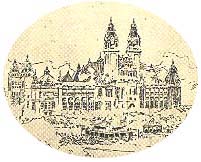
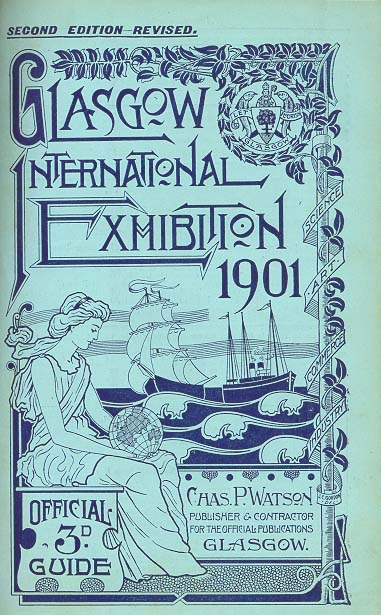 |
As the twentieth century draws to a close with the celebration of Glasgow as City of Architecture 1999, so the century opened with the Glasgow International Exhibition of 1901, an amazing demonstration of Victorian self confidence which proudly displayed the great progress made in industry, science and art during the nineteenth century. Although such exhibitions were popular in France from the seventeenth century onwards, the first truly international exhibition to be held in Britain was the 1851 event held at the custom-built Crystal Palace in London. Proving to be massively popular with the public, its success resulted in a craze for further large - and increasingly grander - exhibitions. The first great universal exhibition held in Glasgow occurred in 1888. This was a roaring success and its profits went towards funding a new and permanent Art Gallery and Museum, to be situated in Kelvingrove Park. Its foundation stone was laid in 1897 and the second exhibition of 1901 was conceived to inaugurate the new building. This was the biggest UK event to be organised so far in the new century, although the 1900 Paris exposition universelle must be given the accolade for being the very first exhibition of the twentieth century. The exhibition was officially opened on 2 May 1901, and it ran until 9 November. |
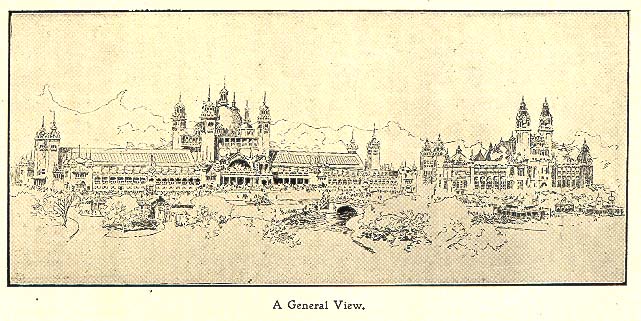 |
| The exhibition site sprawled over 73 acres in Kelvingrove Park in the west of the city. Its centrepiece was the new Art Galley and Museum which appropriately housed the Fine Art section, including work by the "Glasgow boys" who were by now acknowledged as internationally important artists. But the exhibition's main building was the temporary Eastern Palace; its architect was James Millar who won an open competition with his design which satisfied the extravagance demanded by the public. This Oriental fantasy, with its strong suggestions of 16th century Spanish Renaissance architecture, was topped by a grand dome adorned by an electric-torch wielding golden angel of light. There were also separate buildings for industrial and machinery displays, concert halls, foreign pavilions, numerous restaurants and cafes, as well as many minor buildings covering subjects such as agriculture and heating and lighting. Some idea of the sheer scale and grandeur of the enterprise can be realised in examining the exhibition plan below: |
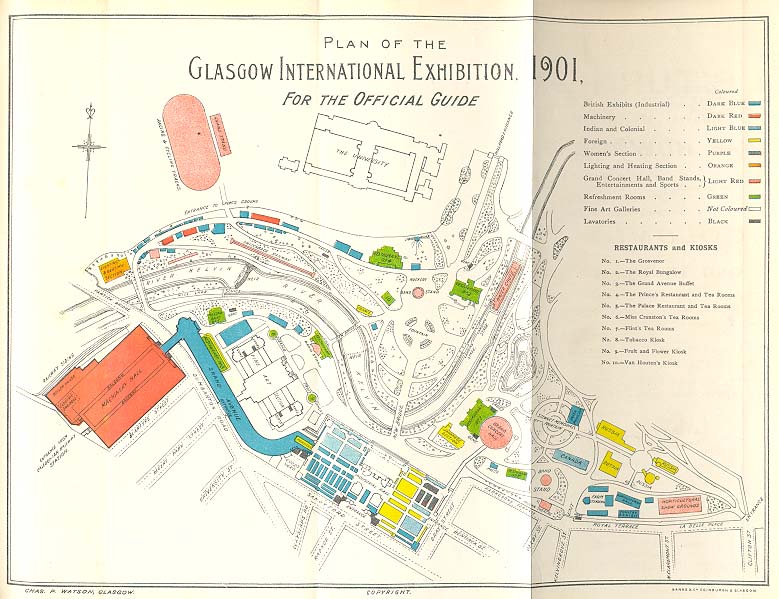 |
| The complexity of organising and mounting such a massive event is hard to comprehend. This was a truly international affair with exhibits and people demonstrating products from all over the world: of the many temporary buildings constructed, for example, a whole Russian village of 7 buildings (4 of them being magnificent pavilions) was erected; there was a model farm complete with working dairy, windmill and grieve's house, a Grand concert hall with seating for more than 3,000, and a new sports ground at Gilmorehill with a four-lap cement cycle track, cinder pedestrian course, football pitch and stand accommodation for 25,000 spectators. The suggestion of limitless resources was enhanced by the breathtaking electrical illuminations which lit up many of the attractions by night. |
| Our book consists of the second edition of the Official
Guide bound together with several of the Official
Daily Programmes (from September, October and
November). As well as obviously describing the exhibition
and its events in some detail, these publications also
provide us with an important source of contemporary
cultural and directory-type information. Glancing at the programme of events for just one day gives us a snapshot of the diverse attractions on offer: concerts by the Rumanian Orchestra, a gymkhana and juggling at the Indian theatre are just some of the activities scheduled for Saturday September 14 which visitors could choose to indulge in, on top of inspecting all the regular displays. While being of great commercial benefit to the manufacturers and industrialists displaying their goods, the exhibition's educational role is stressed in the Guide's introduction, which explains that the reader will find therein: necessary information for a proper understanding and appreciation of all that is offered for enlightenment and education ... the book is expressly designed to present to the mind's eye a panoramic view of the wonders of the Exposition, in all its sections; to enable strangers to make the best use of the time at their disposal, and so to carry home with them an intelligent idea of the world's progress, in civilisation... |
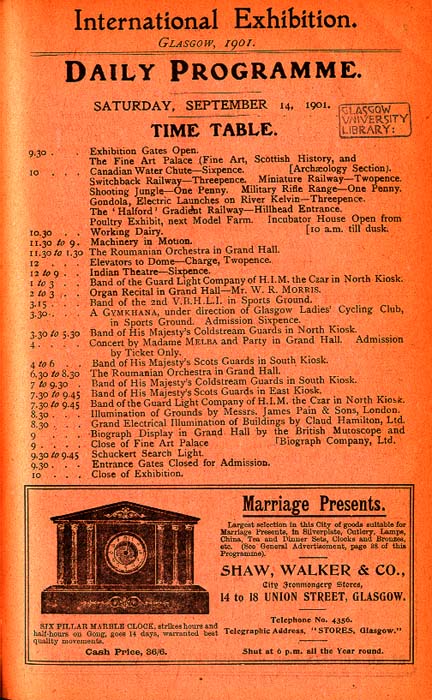 |
| The world's progress was
nowhere better displayed than in the machinery hall which occupied a 6½ acre
site and triumphantly demonstrated Glasgow's claim to be the "workshop of
the world". In the guide, a visionary visitor is imagined admiring the
machines in awe: the thought will no doubt arise that the machines here exhibited, in this year of grace 1901, have a significance and a power for changing the conditions of labour such as machinery never before possessed. Here, in the germ stages perhaps, are the beginnings of those colossal machines, driven by compressed air and electricity, that will produce extraordinary changes in the history of mankind, and make the problems of life weigh heavily on the minds of future generations.
|
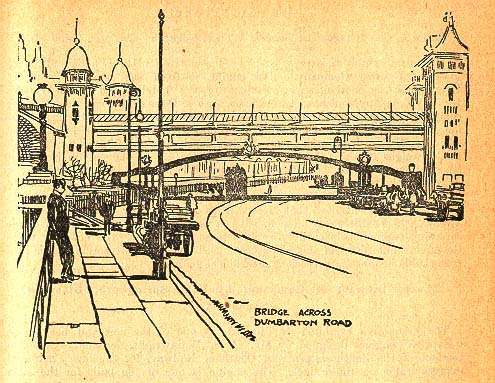 |
The machinery hall was on the far side of Dumbarton
Road, but connected to the industrial section on the main
site by this 1000 feet long covered flyover in which was
incorporated the "Grand Avenue" - a prime
display area for firms: here, for example, models of
steamships could be examined. The visitor could obtain a birds-eye view of the machinery in motion from a wide gallery. The dynamic exhibits included a 40 feet wide waterfall erected by G & J. Weir to demonstrate their pumps.
|
 |
Although the Official Guide might emphasise worthy Victorian self improvement, the exhibition was, of course, also designed to entertain. Amusements included the switchback railway, gondola trips on the River Kelvin, a rifle range, and the most popular of all, the Canadian water chute with its exhilarating plunge into the Kelvin. |
| Although it lacked the novelty of 1888, Glasgow's
second major exhibition was still enormously popular,
resulting in attendance figures of over 11,000,000. Thanks to the railways, journeys were now relatively easy and inexpensive, and tourism was growing. Visitors from afar were encouraged to explore further, and the beauty of the surrounding countryside was heavily promoted in the publicity literature. Here, one of numerous health spas in the vicinity is advertised. |
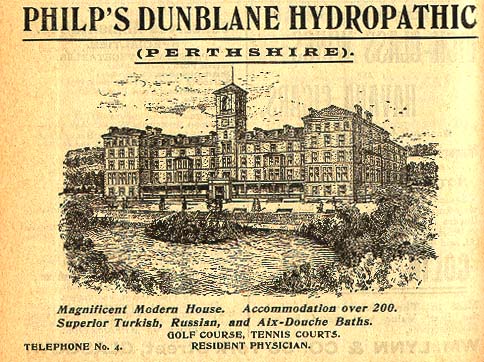 |
| The exhibition was an international shop window. Its
accompanying guides and programmes, which were lavishly
illustrated with advertisements from the participating
companies, meant that information about products could
reach a wide audience far beyond those who could actually
attend in person. While acting as a showcase for new goods such as automobiles and telephones, plenty of more accessible items such as umbrellas were in evidence. As well as the Dido Company's advertisement as shown here, visitors might be lured to the Company's stall by its favourable write-up in the Guide: At the Dido umbrella stand are shown some of the finest parasols and umbrellas stocked by Mr. George M'Culloch, the proprietor of the "Dido" stores. The process of manufacturing is done at the stand. From a large choice of plain and fancy sticks a visitor may make a selection, and have the stick made into an umbrella from any of the covering materials used. Mending is also done while you wait. This is an interesting exhibit. |
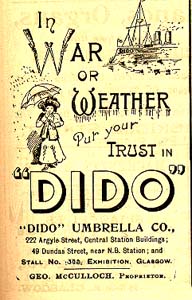 |
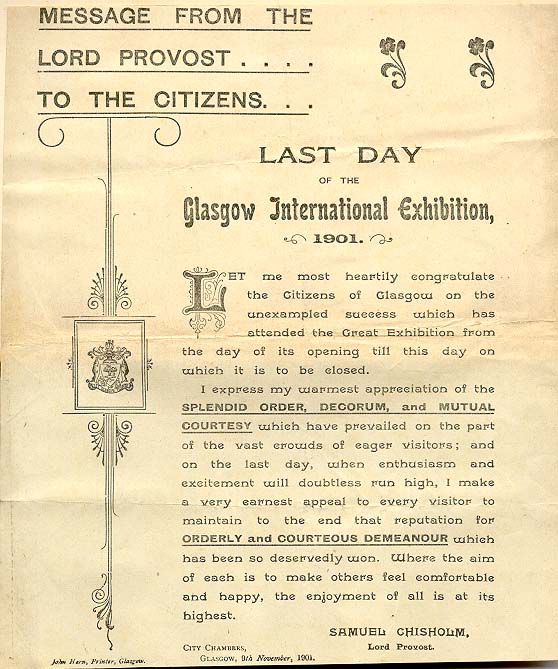 |
This notice is tipped in at the beginning of the
volume. It is an interesting piece of exhibition ephemera
which reflects the trepidation felt by the organisers as
the closing day of 9 November approached. An excited and rowdy crowd bent on plundering the exhibition for souvenirs was expected. As is turned out, rain ensured that many stayed away and there was little trouble. The materials and fittings were auctioned off, and the profit made was invested in restoring the park; the surplus went to the Art Purchase Fund to enhance the new art galleries further. |
| This book comes from the splendid library of David Murray. Murray's interest and enthusiasm for the 1901 exhibition extended to his being responsible for organizing the Scottish archaeological and historical relics on display. Several other subsequent benefactors to the Special Collections Department were also involved: Jessie Marion King was an exhibitor in the decorative arts section; John J. Spencer loaned several books for display from his collection of Darien material; and Lord Kelvin was honorary vice-president of the exhibition and a member of the executive council - his new telephone exchange, incidentally, was also on display. |
Other items of interestA collection of 20 photographs of Glasgow International Exhibition, 1901 Photo B13; Photographic souvenirs Photo A25; Collection of newspaper cuttings, drawings etc. relating to the Exhibition Mu25-b.18; The Exhibition illustrated: a pictorial souvenir of the Glasgow International Exhibition, 1901. With upwards of 400 illustrations Bh12-a.26; Guide and souvenir Bh11-c.40; The official catalogue (first edition) Bh11-c.38; Official catalogue of the Fine Art section Bh11-c.36; Official catalogue of art objects, &c. Mu25-a.30; Official catalogue of the Scottish history and archaeology section Bh11-c.39; Prospectus of Scottish history and archaeology department, fine art, Scottish history and archaeology section in Mu4-b.22; Scottish history & life Mu7-y.13; Russia : its industries and trade Mu25-b.21; Pearson's gossipy guide to Glasgow, the Clyde district and the International Exhibition of 1901 Mu1-b.27; Acknowledgment to Dr David Murray for services rendered to the Exhibition in Mu60-a.29 Return to main Special Collections Exhibition Page Julie Coleman October 1999
|